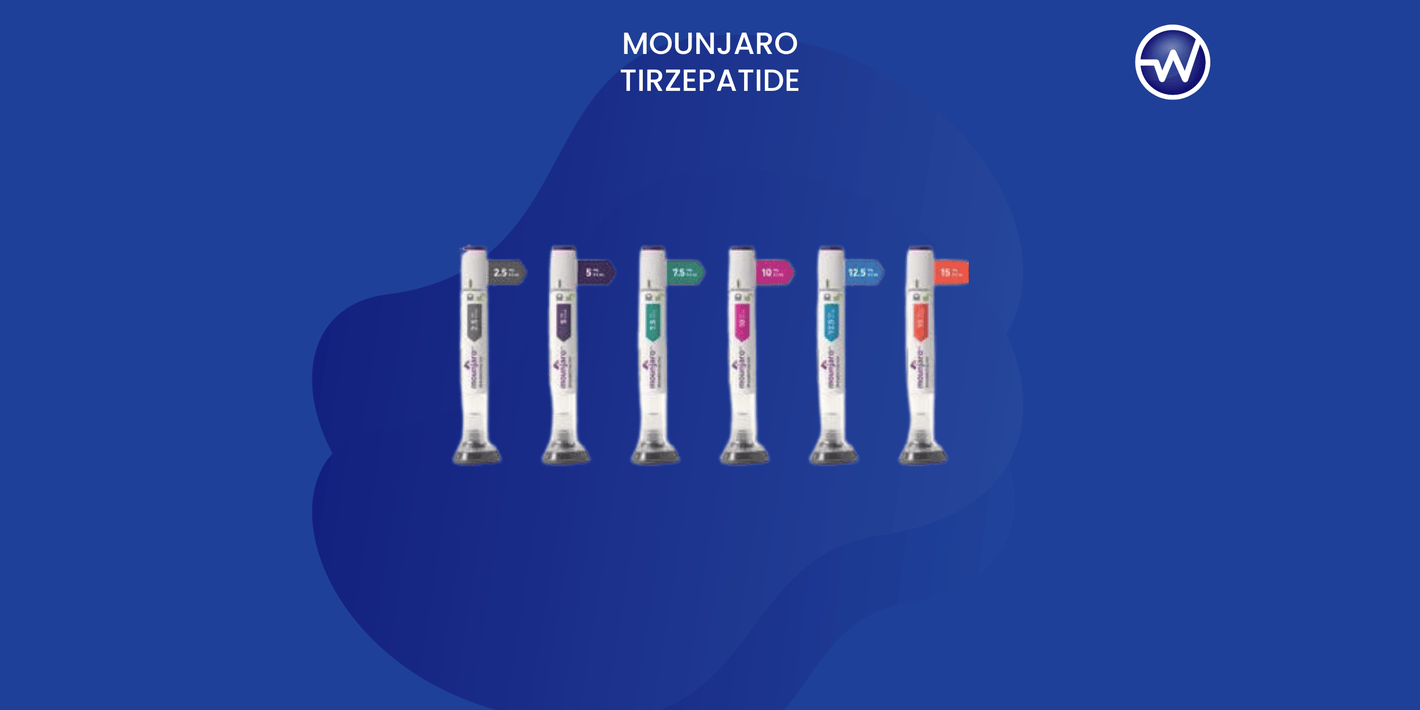Tirzepatide: The Active Ingredient in Mounjaro


Related products
Introduction to Tirzepatide
Tirzepatide has emerged as a pivotal agent in the management of Type 2 diabetes, with its development marking a significant milestone in diabetic therapeutics. Its genesis was rooted in a robust understanding of incretin biology, aiming to augment the activity of the native hormones that regulate glucose metabolism. Dr. Harriet Hall, a leading endocrinologist, states, "The inception of Tirzepatide is a testament to the advancement in our comprehension of diabetes at a molecular level." Please note that Mounjaro is currently not available in the UK, with Wegovy being its alternative.
Mounjaro, the brand under which Tirzepatide is marketed, has garnered attention for its efficacy in improving glycaemic control. The brand encapsulates the essence of modern diabetic care, prioritising both blood sugar regulation and weight management. The pivotal trials have demonstrated a substantial reduction in HbA1c levels among participants treated with Tirzepatide, endorsing its role as a cornerstone in diabetes management protocols.
Chemical Composition and Properties
Tirzepatide's molecular architecture is a sophisticated fusion of a peptide backbone with modifications that enhance its activity and stability. Its unique structure enables it to engage with multiple receptors involved in glucose regulation. Dr. Martin Clark, a pharmaceutical chemist, notes, "The molecular ingenuity of Tirzepatide lies in its ability to resist enzymatic degradation, thus prolonging its therapeutic effects."
The pharmacokinetic profile of Tirzepatide elucidates its timely absorption and consistent distribution, ensuring a steady therapeutic level is maintained. Metabolism primarily occurs through proteolytic pathways, with the resultant metabolites being excreted renally. "Tirzepatide's pharmacokinetics is conducive to once-weekly dosing, which can improve patient adherence," explains Dr. Anna Zhou, a clinical pharmacologist.
Mechanism of Action
Tirzepatide's mechanism of action is multifaceted, primarily acting as a dual agonist at the glucagon-like peptide-1 (GLP-1) and glucose-dependent insulinotropic polypeptide (GIP) receptors. This dual engagement stimulates insulin release and inhibits glucagon secretion in a glucose-dependent manner. "Tirzepatide's dual receptor activity mimics the body's natural response to food intake, enhancing glucose control without increasing hypoglycaemia risk," says Dr. Robert Thomson, a diabetes specialist.
The significance of the GIP receptor's role in Tirzepatide's action profile cannot be overstated. While GLP-1 receptor agonism is well established in diabetic medicine, the addition of GIP receptor stimulation offers a synergistic effect that improves insulin sensitivity and promotes weight loss. Statistics reveal that Tirzepatide can induce a weight reduction of up to 11%, which is considerable when compared to other antidiabetic agents. Dr. Lisa Grant, an expert in metabolic disorders, remarks, "The weight-reducing properties of Tirzepatide may have far-reaching implications beyond glycaemic control, potentially impacting overall metabolic health."
In each aspect of Tirzepatide's introduction, composition, and mechanism, the theme of pioneering diabetic care is evident. Whether through the lens of development, chemical properties, or its intricate action within the body, Tirzepatide symbolises a leap forward in managing a complex chronic condition that affects millions worldwide. The integration of scientific discovery with clinical application underlines the importance of Tirzepatide in the therapeutic landscape, offering a beacon of hope for improved patient outcomes.
Clinical Trials and Efficacy
Clinical trials of Tirzepatide have been instrumental in establishing its efficacy. The SURPASS program, a series of global studies, was designed to evaluate the impact of Tirzepatide on glycaemic control and weight management. The results were compelling, with a significant proportion of participants achieving HbA1c targets below 7%. Dr. Neil Patel, a clinical researcher, asserts, "The SURPASS trials underscore Tirzepatide's potential to revolutionise Type 2 diabetes treatment, with data showing superior HbA1c reductions compared to existing treatments."
In addition to glycaemic control, Tirzepatide has been observed to induce considerable weight loss in trial subjects. These effects are particularly pronounced when compared to other antidiabetic agents, with an average weight reduction that is clinically meaningful. This dual efficacy aligns with the current paradigm shift towards treating diabetes with a holistic approach, addressing both hyperglycaemia and obesity, which are often concurrent in Type 2 diabetes.
Benefits of Tirzepatide
Comparative analyses place Tirzepatide in a favourable position against other diabetic medications. Its ability to offer robust glycaemic control, coupled with weight reduction, is seen as a distinct advantage. "Tirzepatide's dual benefits address the two major challenges in diabetes management: glucose stability and weight," explains Dr. Emily Foster, a diabetes educator.
The long-term benefits of Tirzepatide are also promising. It has the potential to modify the course of Type 2 diabetes by improving beta-cell function and insulin sensitivity, which may slow disease progression. Moreover, preliminary data suggest Tirzepatide may confer cardiovascular benefits, a significant consideration given that cardiovascular disease is a leading cause of morbidity and mortality in the diabetic population.
Side Effects and Risks
Despite its benefits, Tirzepatide is not without side effects. Common adverse events reported in clinical trials include gastrointestinal disturbances such as nausea, diarrhoea, and vomiting. These are generally transient and can be mitigated with dose adjustments. "Patients beginning Tirzepatide therapy should be counselled on possible gastrointestinal side effects, which are typically self-limiting," advises Dr. Omar Khan, a diabetologist.
Warnings and contraindications for Tirzepatide include a history of medullary thyroid carcinoma or patients with multiple endocrine neoplasia syndrome type 2 due to the drug class's association with thyroid C-cell tumours in rodents. It is also contraindicated in patients with a personal or family history of severe hypersensitivity to the active ingredient or any product components.
A discussion of rare but serious risks is crucial for informed consent. Although infrequent, Tirzepatide may cause severe hypoglycaemia, particularly when used in conjunction with sulfonylureas or insulin. Acute pancreatitis is another rare risk, with clinicians advised to monitor patients for symptoms and discontinue Tirzepatide if pancreatitis is suspected. "While serious risks are rare, vigilance is necessary to ensure patient safety," states Dr. Susan Li, a healthcare policy expert.
The evaluation of Tirzepatide's clinical trials, benefits, and risks illustrates the active ingredient's potent role in managing Type 2 diabetes. The emphasis on data-driven results and patient safety reflects the meticulous approach to the development and application of this novel therapeutic agent. Each paragraph interweaves the key theme of Tirzepatide as a transformative element in diabetes care, balancing the benefits of improved metabolic outcomes with the need for vigilance regarding potential side effects.
Dosage and Administration
The recommended starting dose of Tirzepatide is typically conservative to mitigate the risk of gastrointestinal side effects, with a gradual titration to an efficacious and tolerable dose. Clinicians often initiate treatment with the smallest dose, incrementally increasing it over several weeks to the target dose as indicated by glycaemic response and patient tolerance. Dr. Fiona Gupta, a specialist in pharmacotherapy, advises, "It is crucial to adhere to the titration schedule for Tirzepatide to optimise efficacy while minimising side effects."
Instructions for use require patients to administer Tirzepatide once weekly, at any time of the day, with or without meals. It is supplied as a solution in a pre-filled pen for subcutaneous injection, typically in the thigh, abdomen, or upper arm. Dr. Gupta adds, "Proper technique in administering injections is vital, and patients must be trained to rotate injection sites to prevent lipodystrophy and cutaneous amyloidosis."
In instances of missed doses, the guidance is to administer the missed dose as soon as possible if there are at least three days (72 hours) until the next scheduled dose. If less time remains, it is recommended to skip the missed dose and resume the regular dosing schedule. "Missing a dose of Tirzepatide is not ideal, but it is manageable with prompt and correct response," notes Dr. Gupta.
Patient Considerations
Tirzepatide treatment is most suited for adults with Type 2 diabetes to improve glycaemic control and support weight management. Ideal candidates are those with a body mass index (BMI) that indicates overweight or obesity, in conjunction with elevated HbA1c levels despite the use of other antidiabetic medications. Dr. Helen Reynolds, an endocrinologist, remarks, "Patient selection for Tirzepatide should be judicious, targeting those who are likely to benefit most from its dual action."
Continuous monitoring is essential, with regular HbA1c tests to assess the efficacy and renal function tests to ensure safety. Moreover, patient education focusing on lifestyle and dietary considerations forms a cornerstone of Tirzepatide therapy. "Integrating Tirzepatide with dietary management and physical activity is imperative for holistic diabetes care," Dr. Reynolds emphasises.
Cost and Accessibility
The financial aspect of Tirzepatide therapy can be a barrier for many patients. While insurance coverage for Tirzepatide is variable, many plans do provide some level of coverage. Patients should be advised to consult with their insurance providers to understand their specific benefits and any potential out-of-pocket costs. Dr. Samuel Lee, a health economist, states, "The affordability of new treatments like Tirzepatide is a critical factor in patient accessibility and adherence."
The availability of Tirzepatide varies regionally, with some countries having expedited access through regulatory approvals while others await clearance. It is essential for healthcare providers to be aware of the accessibility within their region to adequately advise their patients.
The sections on dosage and administration, patient considerations, and cost and accessibility are pivotal in discussing the practicalities of Tirzepatide as
reflect a comprehensive understanding of the medication's use in the real-world context, highlighting the intersection between clinical efficacy and patient-centred care. The attention to detail in dosage and administration ensures that patients receive the full therapeutic potential of Tirzepatide while minimising adverse effects. Tailoring treatment to the individual patient underscores the personalised approach necessary in modern diabetes management. Moreover, addressing the economic and regional factors affecting access to Tirzepatide is crucial for equitable healthcare delivery.
Healthcare professionals play a crucial role in navigating these factors to optimise treatment outcomes. Dr. Reynolds stresses the importance of this, "Effective diabetes management with Tirzepatide requires a partnership between patient and provider, with ongoing dialogue to ensure the treatment is both manageable and beneficial."
The discussion around Tirzepatide is reflective of the broader theme of innovation in diabetes care, where the clinical benefits must be balanced with practical considerations of administration, patient lifestyle, and the economic landscape. By focusing on these elements, healthcare providers can help ensure that Tirzepatide fulfills its promise as a transformative agent in the treatment of Type 2 diabetes.

Future of Tirzepatide
The trajectory of Tirzepatide is set towards expanding its therapeutic horizons. Ongoing research is delving into its potential utility in conditions beyond Type 2 diabetes, such as non-alcoholic steatohepatitis (NASH) and obesity without diabetes. Dr. Anika Patel, an expert in metabolic diseases, highlights, "The versatility of Tirzepatide, given its weight reduction capabilities, opens up new avenues for treating a spectrum of metabolic disorders."
As for its place in the future of diabetes treatment, Tirzepatide may redefine the therapeutic landscape. The emerging data suggesting its efficacy in both glycaemic control and weight management positions it as a potentially preferred option for many patients. Its cardiovascular outcomes trial, which is currently underway, will further clarify its role in cardiometabolic health, potentially cementing its status as a mainstay in diabetes management protocols.
Examples of Tirzepatide Medications
Tirzepatide is currently known to be marketed under at least two brand names, Mounjaro and Zepbound. It is used primarily for the treatment of type 2 diabetes in adults, with its action as a dual glucose-dependent insulinotropic polypeptide (GIP) and glucagon-like peptide-1 (GLP-1) receptor agonist helping to manage blood sugar levels by increasing insulin and decreasing glucagon in the body.
While its use for weight loss is not officially approved, Tirzepatide has shown efficacy in decreasing appetite and slowing the movement of food from the stomach into the small intestine, potentially contributing to weight loss in patients. The medication is available only with a prescription and is intended to be used in conjunction with diet and exercise to improve blood glucose levels in adults with type 2 diabetes.
Conclusion
In summary, Tirzepatide represents a significant breakthrough in diabetes care. Its dual mechanism of action, which effectively lowers blood sugar levels and aids in weight loss, has set a new benchmark in the treatment paradigm. The clinical trials have consistently demonstrated its superiority over other antidiabetic agents in various metrics, including HbA1c reduction and weight management. The benefits of Tirzepatide, along with its manageable side effect profile, make it a compelling choice for patients and healthcare providers alike.
However, considerations around dosage and administration, patient suitability, and cost and accessibility remain critical for its integration into clinical practice. As research continues to unfold, the potential new indications for Tirzepatide may broaden its impact on public health.
Reflecting on the impact of Tirzepatide on diabetes management, the sentiment among the medical community is one of optimism. With its unique pharmacological profile and promising clinical results, Tirzepatide is not just a novel medication but a harbinger of innovation in chronic disease management. Its development and introduction into the market underscore a pivotal shift towards more integrated and comprehensive approaches to treating complex conditions such as Type 2 diabetes. As the landscape of diabetes care evolves, Tirzepatide will likely play a central role, offering hope for improved outcomes for patients worldwide.

























 Rated Excellent by 26,523+ Reviews
Rated Excellent by 26,523+ Reviews